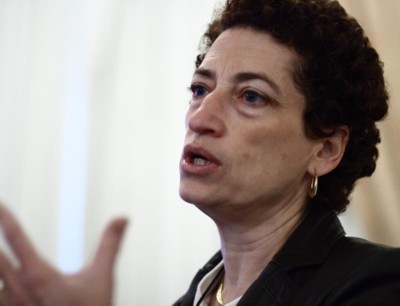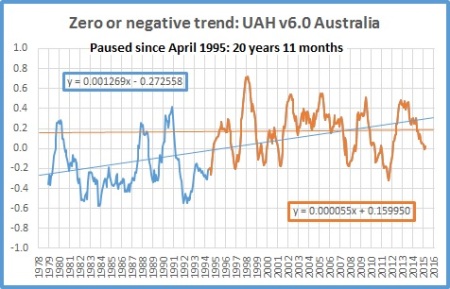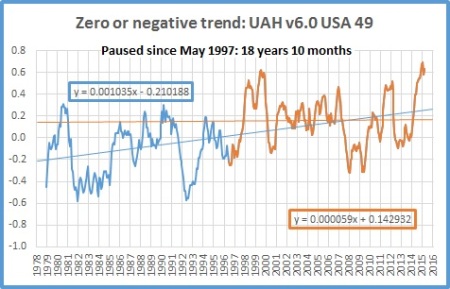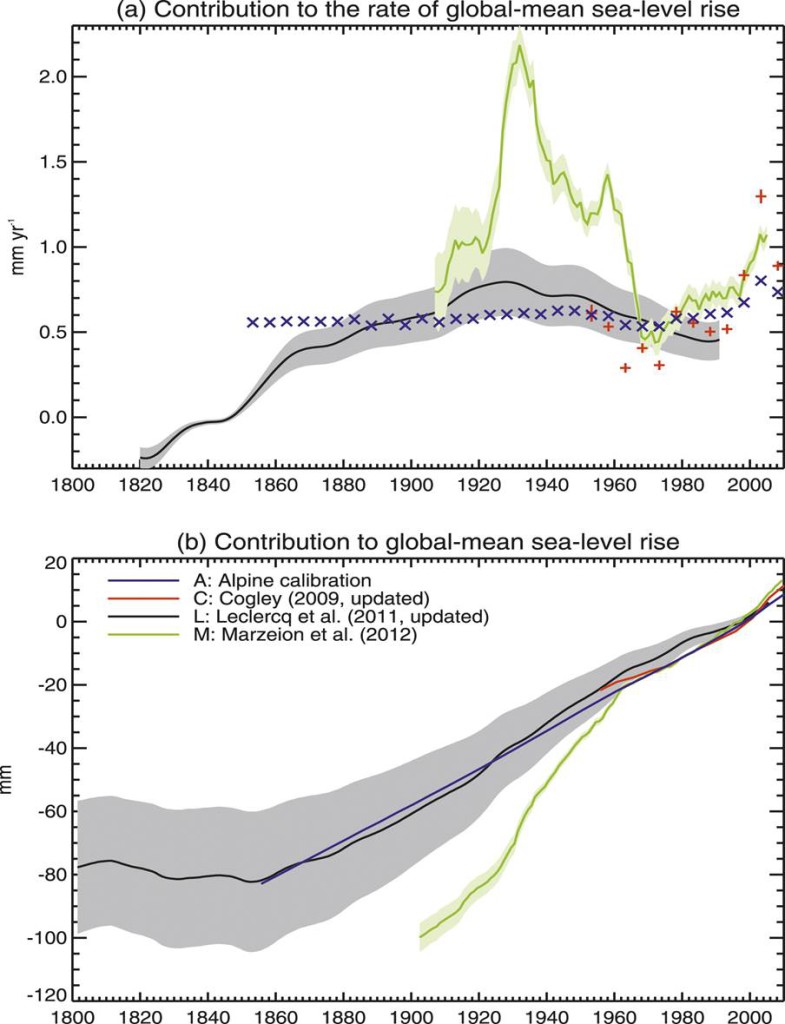Dear Naomi revisited
I had a very nice Naomi in my early life -- Naomi Holbeck. I sometimes wonder where she is now. But the Naomi I want to talk about here is a much less pleasant Naomi: Naomi Oreskes, one of the many climate frauds.

Something that often gives liars away is that they exaggerate. They seem to believe Dr. Goebbels' dictum that big lies are more credible than small ones. The classic example of that is the many elections that various Communist dictators ran in the 20th century. They would always claim that they won 98% or thereabouts of the vote. Nobody believed them of course.
So when Warmists claim that 97% of scientists believe in global warming, historically aware people know how to view that. It's not even a sophisticated lie. Some industrious person has put together a list of 97 published rebuttals to John Cook's 97% claim but it was hardly necessary. One wonders how Cook feels to have his work so swingeingly attacked. I suppose he just wears the usual Leftist carapace of Freudian denial.
But the biggest liar of all was Naomi Oreskes. What she claimed in 2004 was TOTALLY unbelievable. In an article in "Science" magazine she claimed to have done a study of the scientific literature on climate change and found that "none of the papers disagreed with the consensus position". In other words she claimed 100% agreement. She was less truthful than even a Communist dictator. There were already known in 2004 some prominent scientists who were vocal climate skeptics such as Richard Lindzen and Fred Singer. So Oreskes was plainly wrong in claiming that she could find none of them.
The reason I am raking over such old history now is that her work falls neatly into a modern area of scientific concern. In both the social and biological sciences there has been lately a lot of heartburn about unreplicable results. Replication is the test of a scientific claim and it is the central reason why academic articles are so turgid. A believable scientific claim has to go into great detail about how it reached its conclusion so that others can do exactly the same thing to test those conclusions. If someone repeats exactly what an author did and gets DIFFERENT conclusions, a great lightning bolt falls from the heavens and incinerates the original author. Just joking! But the effect is not much less than that. Nobody believes the original claim any more.
And in recent times there have been many attempts to do such exact replications. And the results have been terrible. Around two thirds of established scientific findings in the social and biological sciences have been found to fail replication. Much of what we thought we knew is false.
And the Oreskes claim failed replication. Benny Peiser was one of many who found the Oreskes claim laughable but he was the one who put his money where his mouth was and actually made an attempt to replicate the Oreskes procedures. He got vastly different results. So by modern scientific standards, the Oreskes findings are wrong and should not be quoted as support for anything.
So if anybody now quotes the Oreskes finding without attaching the word "unreplicable" to it, they thereby show that they are out of step with modern scientific standards.
But Warmists abandoned science long ago, of course. In their major papers they withheld details that would allow replications of their work. And when other scientists asked for the withheld details, the Warmists refused point blank to assist. They branded such reqeusts as "harassment". Their response actually made replication unnecessary. It revealed that they themselves knew their work to be fraudulent.
But Naomi has won great honor and glory for her work. Far from being discredited, she has risen greatly in the world. She is now a professor at Harvard. With almost total Leftist control of the media, the bureaucracy and the educational system, the modern world floats on a sea of lies and Naomi is just one of many frauds -- which is why you get Donald Trump, the only prominent figure bold enough to trash completely the Left-led consensus.
Leftist scientists advocating secrecy
They believe in transparency -- for others
The group has been a fierce advocate for transparency, regularly championing investigations that rely on public documents to hold government officials accountable.
But over the past year, the Union of Concerned Scientists, a Cambridge-based advocacy group that represents thousands of scientists around the country, has campaigned to limit the scrutiny of scientists who work for public universities and agencies through public records requests.
These scientists, the group says, are increasingly being harassed by ideological foes who seek to unearth documents that would derail or sully their work with evidence of bias.
“We don’t want to work in an environment where every keystroke is subject to public records,’’ said Michael Halpern, who oversees strategy at the Center for Science and Democracy at the Union of Concerned Scientists, founded at MIT in 1969. “We’re trying to protect the deliberative nature of science. . . . Scientists need space to come to new knowledge, and to give critical feedback.”
But the group’s efforts have sparked tensions with other open-government advocates, who have argued that it risks opening loopholes that could make it easier for officials and agencies to hide information from the public.
“It’s just gibberish to say these laws stifle research,” said David Cuillier, director of the University of Arizona School of Journalism and a member of the Society of Professional Journalists’s freedom of information committee. “These are government scientists funded by taxpayers, and the public is entitled to see what they’re working on.”
The dispute centers on the proper balance between academic freedom and the transparency of public institutions, and has escalated as a growing number of scientists, typically those who research controversial topics such as climate change, receive public records requests.
The requests often seek e-mails between scientists in hopes of exposing ideological bias or a political agenda. While open records laws vary from state to state, the controversy primarily affects researchers at public universities or those involved in projects that receive public funding.
Critics say that many of the requests abuse the spirit of open records laws and threaten to stifle research. They also make it harder for public universities to conduct controversial research and attract top faculty, compared with private universities where scientists aren’t generally subject to open records laws, they say.
“Our role is to raise awareness about how scientists are being harassed,” Halpern said.
Halpern wants exceptions made for scientists in public information laws, and has argued for new standards at federal institutions, such as the National Science Foundation and the National Institutes of Health, that would shield e-mails with fellow scientists, research notes, primary data, and other correspondence they consider confidential.
In a 2015 report titled “Freedom to Bully: How Laws Intended to Free Information Are Used to Harass Researchers,” the Union of Concerned Scientists cited a host of examples of researchers who said they had been harassed by public records requests.
A climate scientist, Michael Mann, who had taught at the University of Virginia and now teaches at Penn State, described how a conservative group called the American Tradition Institute used Virginia’s open records law to seek all his e-mail correspondence with other scientists.
He resisted, and after a lengthy legal battle, the Supreme Court of Virginia rejected the request in 2014, ruling that Mann’s e-mails were exempt from the state’s public records law.
He described the request as an “attack” and said it reflected how public records requests are being used “in a way that they were never intended to be used.”
“What groups like ATI are looking for is a weak link, some institution that, rather than asserting its rights . . . will simply take the path of least resistance (and expense), and cave,” Mann wrote in an e-mail. “That’s why they continue to probe, filing vexatious open records requests against climate researchers in state after state.”
The report also cited the case of Steve Wing, an epidemiologist from the University of North Carolina.
Wing said he was targeted with “extensive and burdensome” public records requests by the North Carolina Pork Council, a trade group, after he released a study in the 1990s linking neighbors’ illnesses to hog farms. The group sought all materials associated with the study, including the names of the study’s participants.
Wing said a university administrator told him he could be subject to criminal prosecution if he failed to comply, and he eventually negotiated a compromise to turn over documents that were redacted to protect the participants’ confidentiality.
But open government advocates note that public records requests have helped expose conflicts of interests involving scientists, such as Wei-Hock Soon, a physicist at the Harvard-Smithsonian Center for Astrophysics who has argued that global warming can be explained by variations in the sun’s energy, rather than increased carbon emissions from pollution.
Through the Freedom of Information Act, environmental groups obtained documents showing that Soon had failed to disclose he had accepted more than $1.2 million from the fossil-fuel industry.
Michael Macleod-Ball, a spokesman for the American Civil Liberties Union who specializes in open records laws, said about two dozen states have some type of exemption to their public records laws for researchers at public universities.
The federal freedom of information law, he said, has no such protections unless the records involve national security, trade secrets, or several other exempt categories.
In Massachusetts, the open records law includes no exemptions for the communications of researchers at public universities. Proposed changes to the records law, slated for debate this year, would not add any.
But state officials, as well as those at public universities, have often cited other exemptions to deny requests or redact records, or only make them available at exorbitant fees. For example, the law allows the University of Massachusetts to exempt “trade secrets or other proprietary information” from public records requests.
The debate has intensified in recent weeks. In a New York Times opinion piece in January, Paul Thacker, a journalist and former congressional investigator, wrote that adding exemptions to public records laws would set a “dangerous precedent.”
“When research is paid for by the public, the public has a right to demand transparency,” he wrote. “Scientists who profess agreement with transparency only when it is on their terms are not for transparency at all.”
Halpern responded on the group’s blog, calling Thacker’s arguments “hollow” and saying they misrepresent the union’s campaign.
“The suggestion that scientists are hypocrites for supporting transparency while opposing absolute disclosure does not hold water,” he wrote.
Halpern said the union supports keeping all correspondence between scientists and government officials open to the public, and acknowledged the challenge in finding the proper line between transparency and confidentiality.
“We have plenty of work to do to increase transparency in science, and rid it of inappropriate influence,” he wrote. “But that doesn’t mean we should scan every handwritten note, record every phone call, or publish every e-mail.”
SOURCE
The "pause" lives on!
An industrious graph-maker (Australian, Ken Stewart) has just turned the latest UAH (satellite) data into a series of graphs, with different graphs for various regions of the world. That supposedly "global" warming was not showing up in his local area was what got him blogging.
So his latest graphs follow on neatly from something I pointed out yesterday: That it is absurd to speak of "global" warming at a time when some parts of the globe are in fact cooling. I offered only the authority of my Crepe Myrtle trees for that observation but our industrious blogger offers the satellite evidence on that. He shows that the trend lines differ from one another in the 11 areas he singles out. Note the final squiggle on the graphs for the USA and Australia. Where the USA squiggles upward, Australia squiggles downwards
I reproduce below only three of his graphs but I think they are the ones of greatest interest: Graphs for the globe, the USA and Australia. He shows that the pause has lasted 18 years and 10 months in the USA but in Australia it has lasted 20 years and 11 months.
UAH v6.0 data for February have been released. Here are updated graphs for various regions showing the furthest back one can go to show a zero or negative trend (less than +0.1C/ 100 years) in lower tropospheric temperatures. Note: The satellite record commences in December 1978- now 37 years and 3 months long- 447 months. 12 month running means commence in November 1979.
Despite the record TLT for February, I am sorry to disappoint GWEs that The Pause has not disappeared. In some regions it has lengthened, in others it has shortened, and in the Northern Extra-Tropics it has disappeared (by my criterion)- but mostly it has remained at the same length.



SOURCE
Pesky! Analysis Finds No Correlation Between Glacier Melt And CO2, Melting Much Slower Today Than 1930s!
According to the below graph (Fig. 2 a) found in Gregory et al., 2013 in Journal of Climate (“Twentieth-Century Global-Mean Sea Level Rise: Is the Whole Greater than the Sum of the Parts?”), there was a very substantial increase in the glacier and ice sheet melt contribution to sea level rise in the early 20th century, reaching up to 2 mm/year sea level rise equivalent.

Source: Gregory et al., 2013 in Journal of Climate
In recent years, the documented rise in sea levels contributed from glacier and ice sheet melt has not come close to reaching the high levels attained during the 1920s and 1930s period as documented by Gregory et al., 2013.
For example according to Shepherd et al., 2012 (see below), the total ice sheet melt contribution from the Antarctic (AIS) and Greenland (GIS) ice sheets combined was 0.59 mm/year (~2.3 inches per century) during the 1992-2011 period and the total ice sheet or glacier melt from all other land sources (not the AIS or GIS) was 0.41 mm/year (~1.6 inches per century) for 2003 to 2010 according to Jacob et al., 2012 (see below).
Together, the total melt contribution from global land ice was about 1 mm/year (~4 inches per century) through the first decade of the 21st century, which is still well below the melt rates achieved during the 1920s and 1930s.
Interestingly, during the 1920s to 1930s period of very high glacier melt rate contributions to sea level rise, human CO2 emissions were flat and only averaged about 1 GtC/year (see graph below).
In contrast, during the 1990s to 2010/2011 period, CO2 emissions rates reached 6 to 9 GtC/year.

Unanswered question
If anthropogenic CO2 emissions are truly driving ice sheet and glacier melt contributions to sea level rise, why was the melt contribution significantly higher during the 1920s and 1930s when CO2 emissions rates were flat and about 1/6th to 1/9th of what they’ve been in recent years?
SOURCE
Britain's crazy energy policy just got madder still
Until last week, the greatest collective flight from reality in the history of British politics was that brought about by Ed Miliband’s 2008 Climate Change Act
Just when we think the world can’t get any madder, along comes something to show that we haven’t yet seen the half of it (who, three years ago, could have predicted the rise of Isil or Donald Trump?). Another such moment came last Monday when our energy minister Andrea Leadsom told MPs that the Government now believes that we should “enshrine” in law the “Paris goal” of cutting our emissions of CO2 to “zero”.
"This 80 per cent figure was at the last minute plucked from the air by Mr Miliband, on the advice of a young lady called Bryony Worthington..."
As we know, arguably the greatest collective flight from reality in the history of British politics was that brought about by Ed Miliband’s 2008 Climate Change Act, which committed Britain, alone in the world, to cutting its “carbon emissions” by 80 per cent. Anyone with a shred of common sense would have known that, with fossil fuels still providing (according to the latest government figures) 84 per cent of all our energy – including 70 per cent of our electricity and pretty well 100 per cent of our transport – while renewable wind, sun and hydro supply less than 2 per cent, it was not entirely rational to set ourselves a goal that could only be reached by closing down virtually our entire economy.
Yet this 80 per cent figure was at the last minute plucked from the air by Mr Miliband, on the advice of a young lady called Bryony Worthington, previously the climate change campaign director for Friends of the Earth, who had been invited to draft an Act which was then supported by all but five of our MPs.
When Mrs Leadsom announced that the Government now wishes to raise that 80 per cent figure to 100 per cent, she offered fulsome thanks to Ed Miliband and the now Baroness Worthington for suggesting it.
She was promptly congratulated by the Green MP Caroline Lucas, whose only reservation was that the Government should also commit itself to producing 100 per cent of our electricity from “renewables”. But even Mrs Leadsom realises that there are times when the wind doesn’t blow and the sun doesn’t shine – so that to keep our lights on, it might be advisable, as a “transitional approach to decarbonisation”, to build a few more gas-fired power stations. But no one is any longer willing to do this, because it would scarcely pay to invest in plants the Government would soon wish to see closed down anyway.
So it seems that Mrs Leadsom is also still pinning her hopes of keeping our economy functioning on two more pipe dreams. One is that plan to get the French to build easily the most expensive nuclear plant in the world at Hinkley Point, which seems to get more dodgy with every month that passes.
The other is the even more costly plan to bribe a few gas-fired power stations to continue running, so long as all their CO2 emissions are piped off to be buried in holes under the North Sea, by a technology not yet developed and which almost certainly never will be.
So carried away into cloud cuckoo land have been all those responsible for our energy policy that Mrs Leadsom now proposes that we should go literally for broke. If our existing policy is like committing suicide by taking ever larger doses of paracetamol, she now wants us to make doubly sure by knocking back a cup of cyanide.
What makes this even more bizarre is that, in doing so, she somehow believes that our “world-leading Climate Change Act” will set an example for all other countries to follow. She wants Britain to be the first to meet that wholly fictitious “Paris goal”, by reducing our greenhouse gas emissions to zero. She conveniently forgets that the Paris agreement committed no one to anything.
China, India and many other countries are planning to build hundreds more coal-fired power stations (of which we will soon have none at all), in a way that will guarantee a further huge leap in the world’s “carbon emissions”, to which our own contribution is now only 1.2 per cent. At least when lemmings jump over a cliff, they are all supposed to do it together. Mrs Leadsom and the rest of our politicians seem happy that we should be the only one.
SOURCE
Crazy German Greenies
The world's first "Green" political party to come to power was the Nazi party so I suppose we should not be surprised at the craziness. The latest example: German PV Power Costs 50 Cents To Produce, Gets Less Than 4 Cents On The Market!
Germany’s Federal Ministry for Commerce And Energy (BMWi) presents a brochure every year with the feed-in act in figures. The brochure lists the costs of the Energiewende (energy transition) in detail. Germany’s EEG feed-in act total subsidy for supporting the Energiewende and expanding renewable energies in 2014 cost approx. 24 billion euros. In 2015 the cost is projected to be some 27 billion euros. From the BMWi figures, it is clear that the major cost driver in Germany’s Energiewende is photovoltaic power.
The following table lists the photovoltaic (PV) power produced in the years 2000-2015 (which was subsidized by the EEG), the average EEG subsidy per kilowatt-hour of solar energy 2000-2015, and the total EEG subsidy for solar energy for PV power ín billions of euros 2000-2015.
The total EEG subsidies paid for PV power rose from 0.015 billion euros in 2000 to almost 11 billion euros in 2015! This is increase is completely due to the installation of total PV capacity shown by the blue bars in the following chart.

The red bars in the above chart show the total subsidies paid each year for PV power. 2015 will see close to 11 billion euros paid in subsidies to support solar power. The heavy black line shows the amount of new installations. New PV installations have trailed off since subsidies for solar energy were scaled back in 2012.
Total installed photovoltaic capacity in Germany has risen from 1 GW in 2003 to almost 40 GW today. The average EEG subsidy for PV power has fallen from 50 cents per kilowatt hour to 30 cents today. Thus the addition of PV capacity continues to surpass the significantly reduced EEG subsidy for PV power, which means total subsidies doled out continue to rise.
With 11 billion euros, PV is the major cost driver of the Energiewende, and accounts for 40% of the total EEG subsidies of 27 billion euros to be paid out this year.
For the 11 billion euros in subsidies, about 1 billion euros of power is actually marketed. That means the subsidies cost a net 10 billion euros annually, which power consumers are forced to pay. That turns out to be about 2.5 cents per kilowatt-hour. For an average household that means about 90 euros per year in extra costs.
For the photovoltaic producers, it’s a great business: Many get 50 cents per kilowatt hour (guaranteed 20 years) while the same kilowatt gets sold for only 3 to 4 cents on the market.
Read here to see the impact this has had on German CO2 emissions (none). Is this insanity, or not?
SOURCE
***************************************
For more postings from me, see DISSECTING LEFTISM, TONGUE-TIED, EDUCATION WATCH INTERNATIONAL, POLITICAL CORRECTNESS WATCH, FOOD & HEALTH SKEPTIC and AUSTRALIAN POLITICS. Home Pages are here or here or here. Email me (John Ray) here.
Preserving the graphics: Most graphics on this site are hotlinked from elsewhere. But hotlinked graphics sometimes have only a short life -- as little as a week in some cases. After that they no longer come up. From January 2011 on, therefore, I have posted a monthly copy of everything on this blog to a separate site where I can host text and graphics together -- which should make the graphics available even if they are no longer coming up on this site. See here or here
*****************************************






 Jim Hansen and his twin
Jim Hansen and his twin


No comments:
Post a Comment